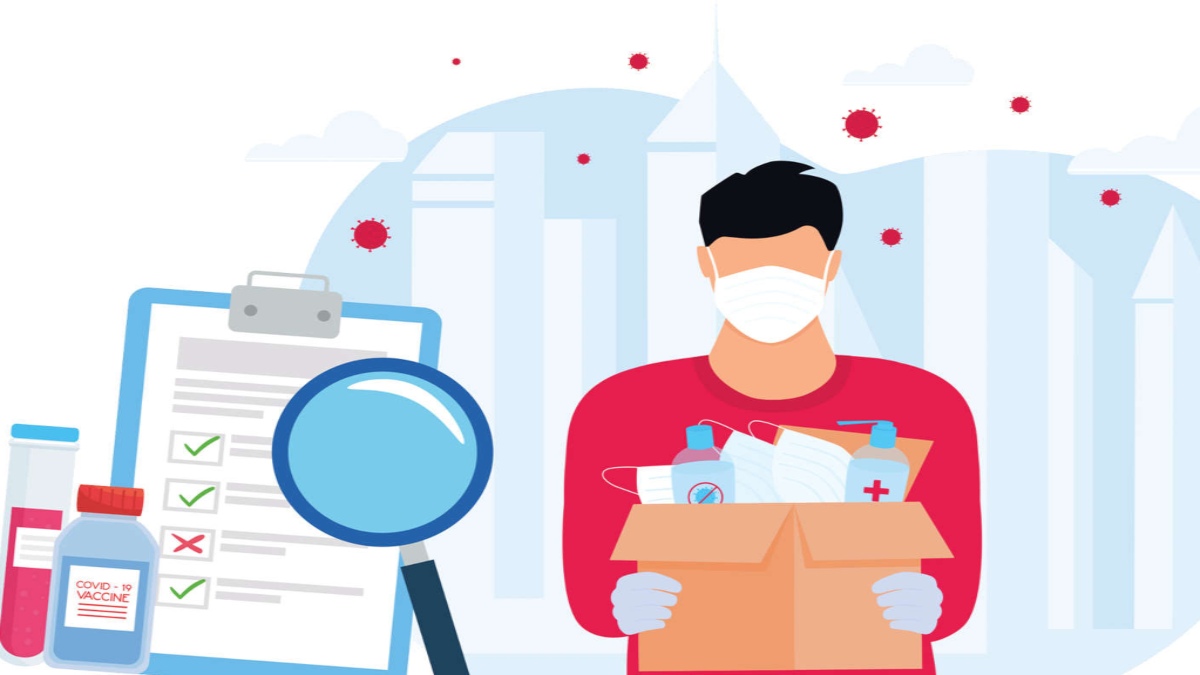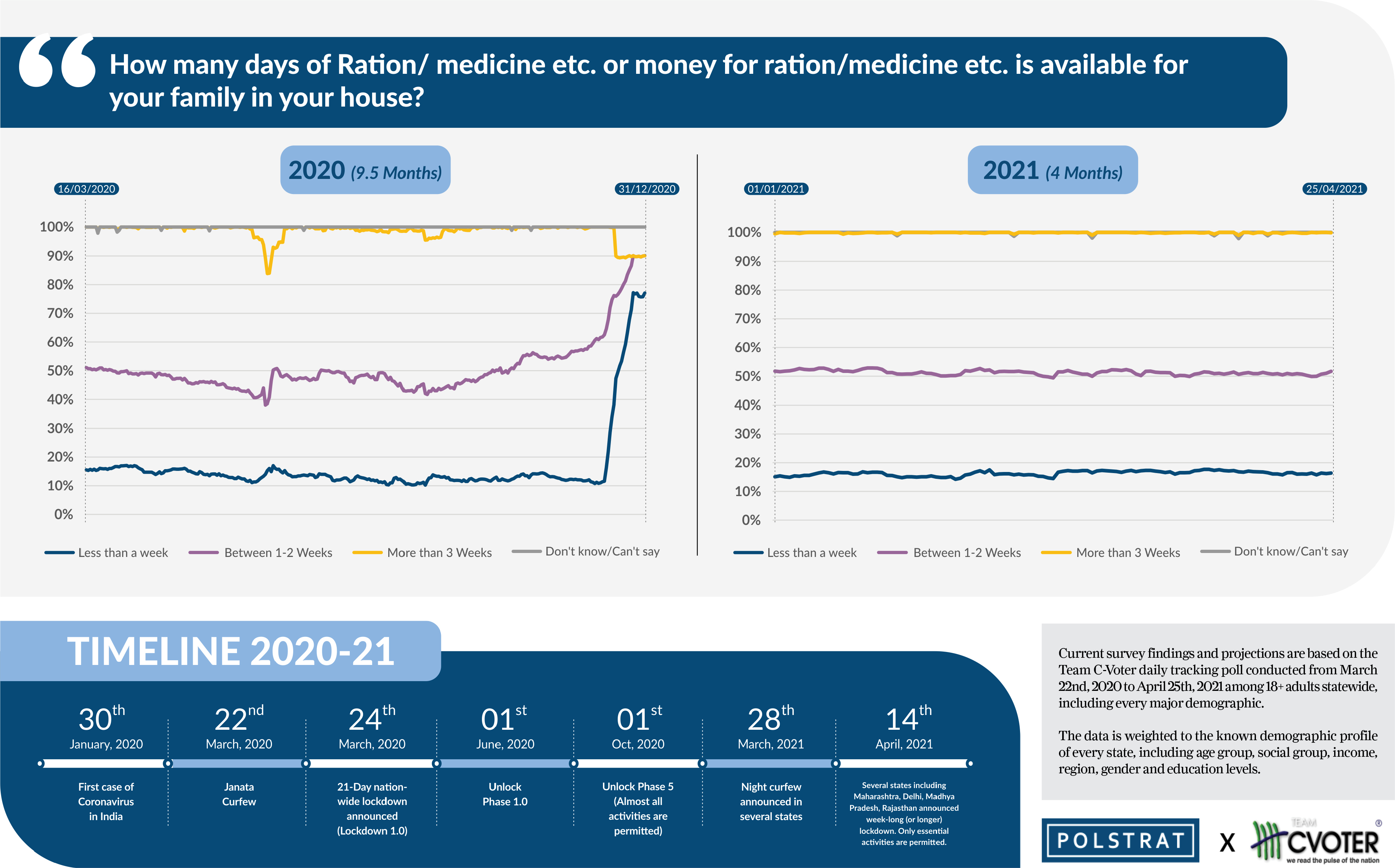


In an attempt to capture the country’s sentiment on the coronavirus crisis, Team C-Voter has been conducting a daily tracking poll from March 16th, 2020 among 18+ adults statewide, including every major demographic. The poll asks questions to respondents across the country about their economic and social well being, along with their sentiments on the fear of the virus and availability of food/ration in their households.



In mid-September 2020, since COVID cases reached a peak of more than 93,000 per day, infections began to decline steadily. By the middle of February 2021, India was only recording an average of 11,000 cases a day. In fact, in early March India’s health minister Harsh Vardhan said the country was “in the endgame” of the pandemic. However, in less than a month the situation changed drastically and the country is in the grips of a deadly second wave of the virus.
As of mid-April, India is experiencing a record-high rise in the daily number of cases every day. On 26th April, India recorded 3.52 lakh new COVID cases in a 24-hour period, the highest daily case count recorded in any country since the discovery of the virus in China more than a year ago. The country is now experiencing a major public health emergency as reports are coming in from all states about shortages of oxygen, ICU beds, ambulances, and essential medications. Using the Team C-Voter daily tracker, we will break down the changes in public opinion about the fear of the coronavirus and public approval of the government’s handling of the past few weeks as compared to the first wave of the virus in 2020.
HOW HAS THE PUBLIC OPINION ABOUT THE THREAT OF THE CORONAVIRUS BEEN CHANGING?

In 2020, during the months of April and May when India was under a series of strict lockdowns, the percentage of people who were scared of getting the coronavirus stabilized at around 41-45%. These numbers began to increase after the announcement of the lockdown relaxations and the unlock phase in the country, reaching an all-time high average of around 60% in August and September 2020. However, since the first week of October, the percentage of those who were scared that they or someone else in their family could catch the coronavirus began to decline.
In January 2021, the percentage of people who said that they were scared that they or someone else in their family could catch the coronavirus was at an all-time low of around 35%. Such low percentages were only recorded before in March of 2020 before the announcement of the Janata Curfew and the subsequent country-wide lockdown. These numbers went as low as 27% towards the end of February when the general public perception seemed to be that India had “defeated” the pandemic.
However, since the last few weeks in March, the fear of the virus has increased substantially once again as the total number of positive cases is touching an all-time high. Around 50% of people have said they fear that they or someone else in their family could catch the coronavirus in the past few weeks. As of April 2021, India is the second-worst affected country in the world by the coronavirus.
HOW HAS INDIANS’ APPROVAL OF THE GOVERNMENT’S HANDLING OF THE CORONAVIRUS BEEN CHANGING?

In 2020, in the days leading up to the Janata Curfew on March 22nd, around 75% of Indians believed that the government was handling the coronavirus crisis well. After the announcement of the first nationwide lockdown on March 24th, this figure began to increase gradually. However, it wasn’t until the first few days of April that over 93% of the respondents said that they thought the government was doing a good job in handling the crisis. This high approval rating continued until the end of May. However, since the announcement of the opening-up of the economy and the subsequent announcement of the unlock phases in June 2020, the percentage of those who agree with the way the government has been handling the crisis had been declining, reaching around 78% towards the end of the year.
Nonetheless, throughout the months of January and February 2021, the percentage of people who agreed with the government’s handling of the coronavirus crisis stabilized at around 80%. This relatively high approval rating continued till the end of March. However, since the last few weeks in March, once again the approval of the government’s handling of the crisis had begun to decline gradually as cases continued to touch record-highs every day. On 21st April, India recorded 312,731 new COVID cases in a 24 hour period, the highest daily case count recorded in any country since the discovery of the virus in China more than a year ago.
While some states such as Maharashtra, Rajasthan and Delhi have lockdown restrictions in place to prevent the explosive spread of the virus, no nationwide lockdown has been announced. India is now grappling with a major public health emergency as reports are coming in from all states about shortages of oxygen, ICU beds, ambulances, and essential medications. However, during an address to the nation, on April 20th, Prime Minister Narendra Modi urged states to announce a lockdown only as a “last measure”. On April 25th, 2021, the percentage of people who approve the government’s handling of the crisis fell to 68.8%. This is the lowest it has been since the start of the pandemic last year in India. During the first wave in 2020, this figure was as high as 94%.
As we can see, the shortage of medical supplies, including necessary medication, oxygen and ICU beds has caused a dip in Indians’ approval of the government’s handling of the coronavirus crisis. In the past few weeks, there has been a huge shortage in availability of oxygen cylinders and tankers which are necessary for transportation of oxygen from manufacturers to hospitals and individuals. This has created a massive shortage in availability of oxygen, which is highly demanded by COVID 19 patients who require urgent oxygen support.
HOW HAS THE AVAILABILITY OF RATION/FOOD IN INDIAN HOUSEHOLDS CHANGED DURING THE CORONAVIRUS LOCKDOWN?
In the days leading up to the Janata Curfew on March 22nd, over 75% of Indian households only had ration/money for ration to last them for less than a week. However, after the announcement of the first nationwide lockdown on March 24th, households gradually began to stock up, with only around 22% having ration/money for ration for less than a week by April 4th.
It is critical to note that throughout various phases of the lockdown, during the months of April and May, roughly 11-13% of Indians still reported having ration/money for ration for less than a week. For a country of 1.35 billion, this would translate to around 150- 175 million people who were living hand to mouth throughout the lockdown period. Even after the opening up of the economy on June 1st, and the subsequent start of the unlock period on June 8th, the majority of Indian households continue to be stocked up, with over 50% of them having enough ration for more than 3 weeks. This trend continued till the end of the year, with roughly 50% of households stating that they had food/money for food for more than 3 weeks, while around 15% were living hand to mouth, with food/money for enough supplies only to last them for less than a week.
Towards the middle of April, as coronavirus cases skyrocketed across the country, several states, including Rajasthan, Maharashtra, Delhi, Punjab, and Karnataka imposed severe restrictions, eventually leading to the announcement of a complete lockdown. When comparing the figures from 2020 and 2021, we observe that throughout April and May in 2020, when a strict lockdown was ongoing in the country, the percentage of people who said they only have ration/money for ration for less than a week was around 11-13%. On the other hand, in 2021, from the end of March till mid-April (as restrictions are being put in place) this percentage is slightly more at around 15-17%. Once again, to put this into perspective, for a country of about 1.35 billion people, this would translate to around 200-215 million people who are now living hand to mouth as a result of the lockdown imposed to curtail the spread of the second wave of COVID-19.
India is currently experiencing a deadly second wave of coronavirus crisis and as we continue to be under lockdown to fight the spread of the disease, another need is to fight against the spread of misinformation and inaccurate perception which can be as deadly as the virus. Our team at Polstrat hopes that everyone is staying safe and following all government guidelines to help curtail the spread of the virus. Through our tracking poll, we will continue to keep you updated on changes in public perception of the virus.

Current survey findings and projections are based on the Team C-Voter daily tracking poll conducted from March 22nd, 2020 to April 25th, 2021 among 18+ adults statewide, including every major demographic.
The data is weighted to the known demographic profile of every state, including age group, social group, income, region, gender and education levels.